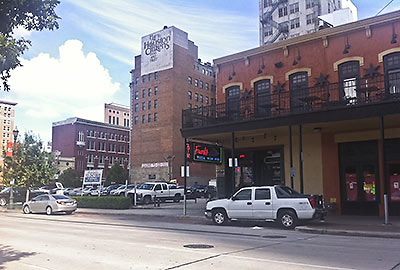
All day Friday these 3 parking spots in Market Square in front of Frank’s — and where Hines wants to build that 33-story residential tower — will be unavailable. Why? Well, Gensler and the Houston chapter of the American Society of Landscape Architects (including firms Asakura Robinson, SWA Group, M2L, and Elizabeth Austin Landscapes) are gonna be using ’em to set up a parkette for National Park(ing) Day.
Just as the similarly hopeful Better Block project attempts to reproduce pedestrian-friendly street life for a few hours in a controlled environment, these wee pop-up parks work like dioramas of urban leisure: A rep tells Swamplot that a shade structure, trees, shrubs, and board games (checkers and Jenga, yo!) will be rolled in and set up here at 417 Travis from 8 a.m. to 5 p.m. for anyone who wants to park it and stay awhile.
Additionally, a group of architecture students from Texas Tech are trying to stimulate the same simulation at the corner of Leeland and St. Emanuel in East Downtown, near the food trucks at the Houston Food Park.
- Houston Park(ing) Day [Facebook]
- Previously on Swamplot: A Few New Views of the 33-Story Apartment Building Hines Wants To Build in Market Square, A First Look at Some of the 33-Story Apartment Tower Hines Wants To Build in Market Square, How To Build a Buffalo Bayou Pedestrian Bridge: A Photo Tutorial, Hines Interested in Building Residential Tower on Downtown Block Near Market Square Park, East Downtown’s Food Truck Parking Park, Planning for the Future of Washington Ave, The Great Houston Street Life Simulation
Photo: Barbara Novoa


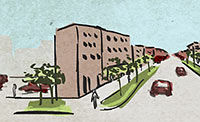 “The idea of requiring on-site parking to be put somewhere else beside the primary frontage along the street was considered during the Urban Corridors process (that led to the current Transit Corridor ordinance). The message from the development community was loud and clear: you cannot prohibit front-door parking within a certain area — that makes properties just outside the boundary of the restriction more valuable and attractive to a greater range of potential occupants, and therefore unfairly diminishes the value of the restricted properties. The idea of making such a restriction mandatory was thus scrapped; it is now an ‘opt-in’ feature of the ordinance in return for the ability to do a reduced setback. Only on streets in light rail corridors though — it doesn’t apply in places like Washington and Rice Village, sadly.” [
“The idea of requiring on-site parking to be put somewhere else beside the primary frontage along the street was considered during the Urban Corridors process (that led to the current Transit Corridor ordinance). The message from the development community was loud and clear: you cannot prohibit front-door parking within a certain area — that makes properties just outside the boundary of the restriction more valuable and attractive to a greater range of potential occupants, and therefore unfairly diminishes the value of the restricted properties. The idea of making such a restriction mandatory was thus scrapped; it is now an ‘opt-in’ feature of the ordinance in return for the ability to do a reduced setback. Only on streets in light rail corridors though — it doesn’t apply in places like Washington and Rice Village, sadly.” [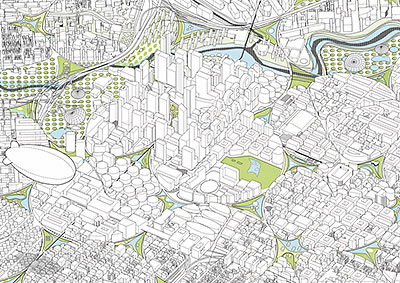
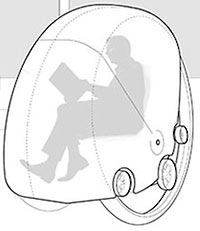
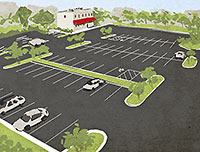 “In my line of work I look at parking requirements for different cities around the country all day long, and Houston’s are pretty high. 10 per 1,000 SF for a restaurant means you need a parking space for every 100 square feet. This means for every 10 ft x 10 ft block of floor space in your restaurant, you’re expecting that the people occupying that space drove ten different cars to get there. Is any restaurant ever so packed that there are 10 people for every 100 SF of space (including the whole area of the restaurant, not just the dining area), and all of them driving a separate car?
I guarantee you this: a city that requires that ten paved parking spots exist every time there’s 100 square feet of people dining somewhere will never be an interesting city. If you need that much flat pavement everywhere that people like to hang out and cluster, you’re going to concrete and asphalt yourself away from ever having an interesting district. You might manage to get something going in the parts of town that were built before the draconian regulations took effect, but pretty soon people are going to want to build new things in those areas, the new requirements will kick in, and pavement will start spreading like a cancer.” [
“In my line of work I look at parking requirements for different cities around the country all day long, and Houston’s are pretty high. 10 per 1,000 SF for a restaurant means you need a parking space for every 100 square feet. This means for every 10 ft x 10 ft block of floor space in your restaurant, you’re expecting that the people occupying that space drove ten different cars to get there. Is any restaurant ever so packed that there are 10 people for every 100 SF of space (including the whole area of the restaurant, not just the dining area), and all of them driving a separate car?
I guarantee you this: a city that requires that ten paved parking spots exist every time there’s 100 square feet of people dining somewhere will never be an interesting city. If you need that much flat pavement everywhere that people like to hang out and cluster, you’re going to concrete and asphalt yourself away from ever having an interesting district. You might manage to get something going in the parts of town that were built before the draconian regulations took effect, but pretty soon people are going to want to build new things in those areas, the new requirements will kick in, and pavement will start spreading like a cancer.” [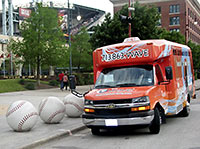 It’s not as well-designed orÂ
It’s not as well-designed or 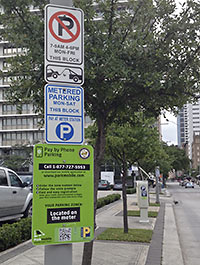 Downtown District rep Angie Bertinot tells abc13 that the organization counted more than 100 “different unique” parking signs mucking things up for drivers hoping to avoid getting towed or ticketed — and in response
Downtown District rep Angie Bertinot tells abc13 that the organization counted more than 100 “different unique” parking signs mucking things up for drivers hoping to avoid getting towed or ticketed — and in response 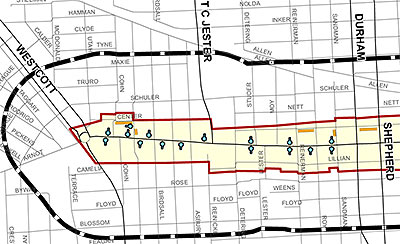
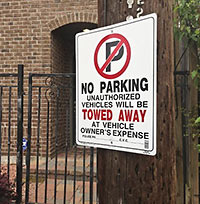 A sign like the one shown here is indicative of “a growing problem” inside the Loop, reports abc13’s Miya Shay, who claims that some homeowners and businesses are resorting to a creative way of keeping would-be parkers off the street: “If you notice,” resident Joanne Witt tells Shay, “[the sign] doesn’t have [a] police phone number and it doesn’t say where it’s going to be towed. I’m assuming it’s just put up to scare people.” And how will you know where you can park? Shay tries to clarify: “
A sign like the one shown here is indicative of “a growing problem” inside the Loop, reports abc13’s Miya Shay, who claims that some homeowners and businesses are resorting to a creative way of keeping would-be parkers off the street: “If you notice,” resident Joanne Witt tells Shay, “[the sign] doesn’t have [a] police phone number and it doesn’t say where it’s going to be towed. I’m assuming it’s just put up to scare people.” And how will you know where you can park? Shay tries to clarify: “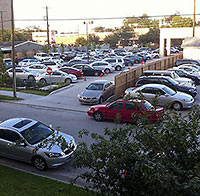 City council approved today by a vote of 14-2 changes to the off-street parking ordinance that hasn’t really been
City council approved today by a vote of 14-2 changes to the off-street parking ordinance that hasn’t really been